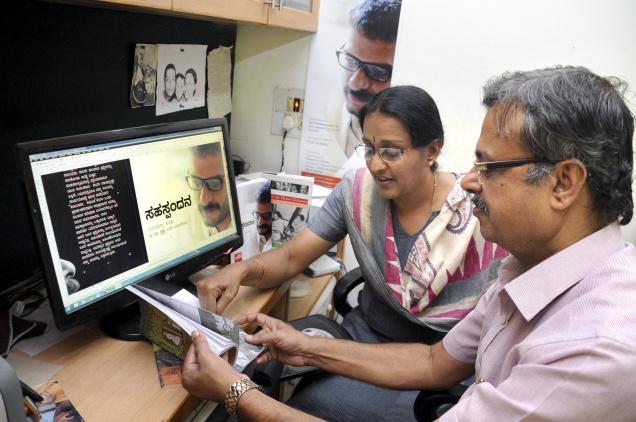
Venugopal and Shylaja run an unusual music magazine from Mysore, Ragamala. This stunningly produced publication will be out with its third volume on April 6
Venugopal teaches statistics at Maharani’s Science College, Mysore. Shylaja teaches English at Government First College, Nanjanagud. Apart from their interest in history, economics and women studies, the couple are music lovers. In 2013, the duo started a niche magazine on music, Ragamala. Stunningly produced, the magazine predominantly features articles that are translated from English to Kannada. The magazine digs into the archives of musical history and brings together a whole lot of views on music and musicology, written by musicians, litterateurs and musicologists at different points of history, apart from a rich treasure of photographs. While their first issue was on Pandit Ravi Shankar – Godfather of World Music, the second is Kelu Janamejaya, collating ideas on listenership. The third magazine will be released on April 6, which is a collection of articles by Carnatic vocalist T.M. Krishna, Sahaspandana. Ragamala, as it is evident from its content and design, is a magazine that is striving to be serious, unlike other music magazines that have walked the hall of fame and currently run on reputation.
Excerpts from an interview:
When and how did the idea of this music magazine come about?
The idea of Ragamala took shape during informal discussions with Sarod maestro Pandit Rajeev Taranath. He felt that something worthwhile about music should be brought out in Kannada. He was particular that it had to be on music and not the musician because majority of the writings are on the musician. These discussions led to the birth of Ragamala. It was exactly at this time that Sitar maestro PanditRavishankar passed away. By default the first issue of Ragamala was on him. Classical music like any other classical art form needs some initiation and training. It is important to understand what to listen for in music. With this in mind, Rajeevji conducted two sessions of guided listening – one on music in general and another exclusively on listening to instrumental music. This formed the background for the second book “Kelu Janamejaya” about music listening.
As editors what do you perceive as the problems of putting together and bringing out a niche magazine like this?
Basic problem is we are new to this type of scholarship. Creating abstraction of music through language is very challenging. Serious scholarship on music is also less in Kannada.
What kind of response has the magazine elicited? Are the readers of your magazine connoisseurs of music or has it attracted general public too? Did you have a target audience in mind?
First we thought of reaching people who are already into music and have a dialogue with them through Ragamala and its activities. It was a pleasant surprise that many from general public, who were from different backgrounds responded very positively to the book. In fact, some told that the series created a confidence in them that classical music is not beyond them. But our readership is very limited.
Your magazine deals with both Hindustani and Carnatic music. The first issue is on Pandit Ravishankar and the second deals mostly with Carnatic. Do you have an editorial advisory team? How do you decide what goes into an issue?
We don’t have a formal editorial board. Ours is a loose group. We discuss with people who are very well versed in their respective fields and in the process many ideas come. If an expert in a particular area of music is capable of editing a particular issue and willing to help us then we prefer to entrust him/her with the responsibility of that issue. For instance, one of the forthcoming issues is on the music and musical experiments of Pandit Rajeev Taranath. We have requested Dr. Krishna, a professor of English and a disciple of Rajeevji to edit that issue. This will make the book really worthy. In fact, the issue on music listening started with the idea of documenting guided listening programme. Finally it resulted in something different. Shylaja is initiated into Carnatic music formally. We are ardent listeners of both Hindustani and Carnatic music.
Your second issue, Kelu Janamejaya is about listenership. Has it undergone a major change in the recent times?
Yes, many are attracted to classical music. The question is more about the quality of listeners. Once we start learning the rules of the game, we can appreciate the game better. Musicians need informed listeners. Like culture, taste is also acquired over a period of time.
Your next issue is a collection of articles by T.M. Krishna in Kannada.
We feel that the questions T.M. Krishna has been raising can’t be ignored. They are very crucial. Definitely they will expand the horizon of our understanding of Carnatic music. His articles on GNB, Kishori Amonkar can be considered a model for music criticism. His thoughts on bhakti, dharma, gender, caste are very vital and we feel that there is an urgent need to address these issues. It is perhaps the right time too. We agree with TMK’s view that now Carnatic music is safe, it has guaranteed audience and now we can take the risk of discussing these issues.
I feel that the magazine doesn’t give details about the source of its articles and photographs. Historical details are important for us to map the movement of history itself.
We totally agree with you. Historical details are important. We are also learning in the process and trying to correct ourselves. The second book has the list of source materials at the end of each article. We need to be more meticulous. It is a process of learning for us too.
(For copies, write to CH-73, 7th Main, Saraswathipuram, Mysore – 570009)
source: http://www.thehindu.com / The Hindu / Home> Features> Friday Review> Music / by Deepa Ganesh / Mysore – April 03rd, 2014